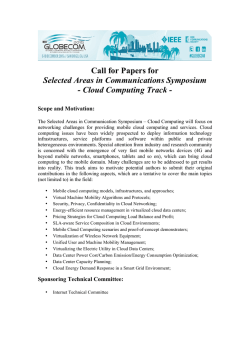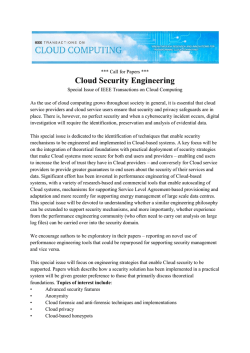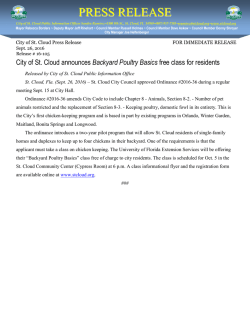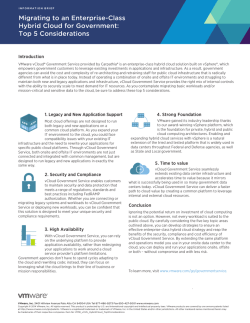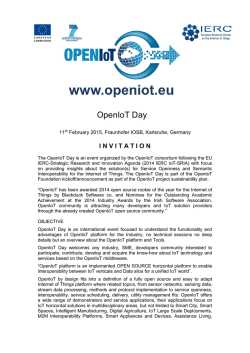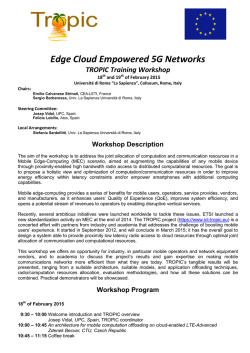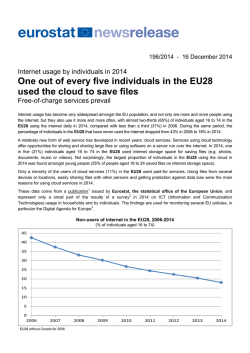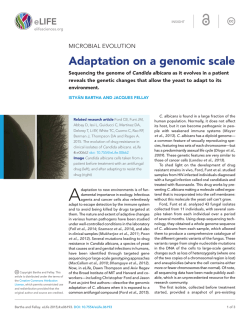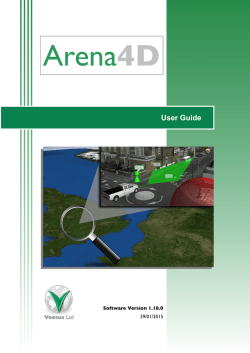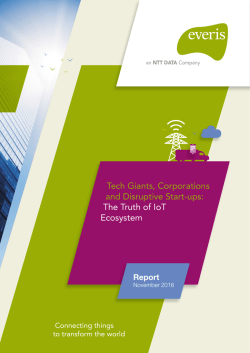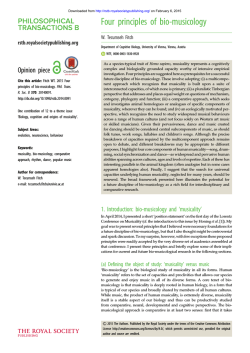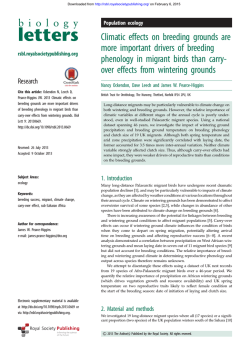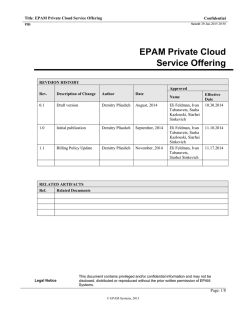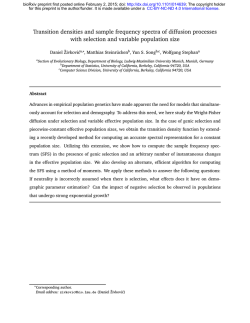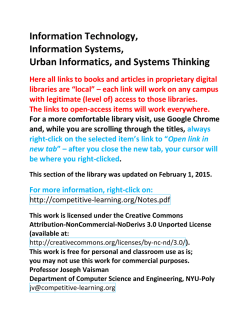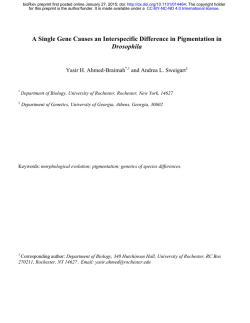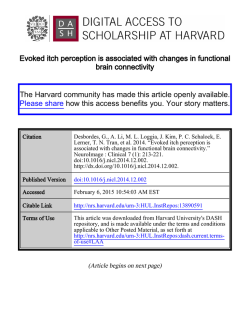
concepts of the internet of things from the aspect of the autonomous
Interdisciplinary Description of Complex Systems 13(1), 34-40, 2015 CONCEPTS OF THE INTERNET OF THINGS FROM THE ASPECT OF THE AUTONOMOUS MOBILE ROBOTS Janos Simon* Subotica Tech – College of Applied Sciences Subotica, Serbia DOI: 10.7906/indecs.13.1.5 Regular article Received: 29 September 2014. Accepted: 3 January 2015. ABSTRACT The Internet of Things (IoT) is slowly gaining grounds and through the properties of barcodes, QR codes, RFID, active sensors and IPv6, objects are fitted with some form of readability and traceability. People are becoming part of digital global network driven by personal interests. The feeling being part of a community and the constant drive of getting connected from real life finds it continuation in digital networks. This article investigates the concepts of the internet of things from the aspect of the autonomous mobile robots with an overview of the performances of the currently available database systems. KEY WORDS IoT, mobile robotics, DBMS performance, cloud computing, wireless sensor networks CLASSIFICATION ACM: D.1.1. JEL: Z19 *Corresponding author, : [email protected]; +381 24 655 221; *Marka Oreškovića 16, 24000 Subotica, Serbia * Concepts of the internet of things from the aspect of the autonomous mobile robots INTRODUCTION Information and communication technology has started on large computers called the main frame of the 1960s, the 1970s minicomputer was a practical solution, workstation appeared with the development of the microprocessor in the 1980s, and personal computers became popular in the 1990s. This progress is largely accelerated due to the development of a semiconductor integrated circuit technology [1]. As a result, the computer and the network cost, made a remarkable progress in terms of performance, have infiltrated and became embedded into the society at large scale. In a network, stemming from the Internet to research of ARPANET, by the 1990s WWW (World Wide Web), showed the explosive spread. In the background, it may become capable of high-speed large-capacity communication by development of optical communication technology. From the wireless communication technology, to the spread of mobile phones and high-speed wireless LAN, all the equipment leads to the era of the global network. Dramatic improvement in communication speed, and to underpin the transition from e-mail to the video content, the fusion of communication and broadcasting has begun and started an expansion of the IoT devices as shown in Figure 1. INTERNET OF THINGS The Internet of Things is not a single standalone technology, It is a concept in which most new things are connected and enabled such as street lights being networked and things like embedded sensors, image recognition functionality, augmented reality, near field communication are integrated into situational decision support, asset management and new services [2]. These bring many business opportunities and add to the complexity of IT. Figure 1. IoT devices and the future evolution. The Internet of Things offers solutions based on the integration of information technology, which refers to hardware and software used to store, retrieve, and process data and communications technology which comprises electronic systems used for communication between individuals or groups [3]. The rapid convergence of information and communications technology is occurring at many layers of technology innovation (Fig. 2): the cloud, data and communication pipes/networks and device. 35 J. Simon Figure 2. IoT Layered Architecture. The potential market for wireless communication technology is one of the rapidly-spreading segments in the industry of integrated circuits. Breathtakingly fast innovation, fast changes in communications standards, the entry of new players, and the evolution of new market sub segments will lead to disruptions (disorder, confusion) across the industry [4]. IOT AND AUTOMOMOUS MOBILE ROBOTS The connection of vehicles or mobile robots to the Internet brings about a wealth of new possibilities and applications which bring new functionalities to the individuals and/or the making of transport easier and safer. In this context the concept of Internet of Vehicles (IoV) connected with the concept of Internet of Energy (IoE) represent future trends for smart transportation and mobility applications as depicted (described, shown, illustrated) in Figure 3 [5]. Self-driving vehicles today are in the prototype phase and the idea is becoming just another technology on the computing industry’s parts list. Using automotive vision chips that can be used to help vehicles understand the environment around them by detecting pedestrians, traffic lights, collisions, drowsy drivers, and road lane markings [6]. Those tasks initially are more the sort of thing that would help a driver in unusual circumstances rather than take over full time. MICROCLIMATIC CONTROL USING IOT Control of the microclimate is achieved through collecting parameters with the help of a Figure 3. Converging Technologies. 36 Concepts of the internet of things from the aspect of the autonomous mobile robots mobile measuring station, preparing, processing data and performing control activities making possible to reach the desired goals as illustrated in Figure 4. After processing, the control system provides information about the operation of the system and sends control signals to the actuator. The executive element takes over the energy from the auxiliary electrical source and proportionally to the control signal adapts the flow of matter and/or energy on the control input [7]. The sensor network is a divided system which makes the sensor field of various types mutually connected with a communication network [11]. The sensor network consists of from individual multifunctional sensor nodes [10]. Figure 4. Structure of the controlled microclimatic environment. In most cases the nodes connect wirelessly into a communication network, thus forming a Wireless Sensor Network – WSN. The WSN consists of battery-powered modules, which, in fact, represent sensor nodes [8]. The basic surface of the experimental model of the microclimate environment is 15,33 m2. The model is built for experimental purposes and it is situated in the yard of Subotica Tech – College of Applied Studies in Subotica, Serbia. In order to use the microclimatic environment effectively throughout the year under CentralEuropean climatic conditions it is necessary to heat the greenhouse in winter, and cool it in summer. Such a system should be automated as much as possible [9]. Microclimate control in greenhouses is a responsible and complex process because there are many factors which influence the climate, which are interdependent. In order to achieve the goal of the highest possible crop on the given plot while maintaining appropriate product quality, it is necessary to provide suitable microclimatic conditions, while ensuring that this goal is achieved by consuming the least possible quantity of energy [11]. CONTROL DATA STORAGE TO THE CLOUD By its name, a cloud database is a database that runs on a cloud computing platform, such as MS Onedrive, Dropbox and Google drive. The cloud platform can provide databases as a specialized service, or provide virtual machines to deploy any databases on. Cloud databases could be either relational or non-relational databases. Compared to local databases, cloud databases guarantee higher scalability as well as availability and stability [16]. Thanks to the elasticity of cloud computing, hardware and software resources can be added to and removed from the cloud without much effort. Users only need to pay for the consumed resource while the expenses for physical servers, networking equipments, infrastructure maintenance and administration are shared among clients, thus reducing the overall cost. Additionally, database service is normally provided along with automated features such as backup and recovery, failover, on-the-go scaling, and load balancing. 37 J. Simon Cloud computing has been established as one of the major building blocks of the Internet of Things [17]. New technology enablers have progressively fostered virtualisation at different levels and have allowed the various paradigms known as “Applications as a Service”, “Platforms as a Service” and “Infrastructure and Networks as a Service”. As part of this convergence, IoT applications such as sensor-based services will be delivered on-demand through a cloud environment. This extends beyond the need to virtualize sensor data stores in a scalable fashion. It asks for virtualization of Internet-connected objects and their ability to become incorporated into on-demand services such as Sensing-as-a-Service. Figure 5 shows the performances of tested database management systems. The choice of the databases was based on the fact that those were among the most popular databases available, and that they were the representatives for their kinds. Many large organizations have been using them in production, such as Facebook, Google, Wikipedia, LinkedIn, Instagram, etc. On the other hand, each database has its own promising strength that is worth exploring. MySQL so far has been the most popular open source SQL database. MongoDB was built to work with very large sets of data [17]. CouchDB has its user-friendly RESTful API. Meanwhile, Redis is said to be very fast thanks to its in-memory storage. Redis is an open source, BSD licensed, advanced key-value cache and store system. With the bulk data, the MongoDB has the smallest latency, but the overall best score goes to MySQL. Figure 5. Bulk insert latency test with various DBMS. CONCLUSIONS The concept of Internet of Vehicles (IoV) is the next step for future smart transportation and mobility applications and requires creating new mobile ecosystems based on trust, security and convenience to mobile/contactless services and transportation applications in order to ensure security, mobility and convenience to consumer-centric transactions and services. This requires robust sensors and actuators which are able to reliably deliver information to the systems mentioned above. Such reliable communication needs to be based on M2M communication protocols which consider the timing, safety, and security constraints. The vision of the future Internet of Things is setting new challenges and opportunities for data management and analysis technology. Gigabytes of data are generated everyday by millions of sensors, actuators, RFID tags, and other devices. As the volume of data is growing dramatically, so is the demand for performance enhancement. When it comes to this 38 Concepts of the internet of things from the aspect of the autonomous mobile robots Big Data problem, much attention has been paid to cloud computing and virtualization for their unlimited resource capacity, flexible resource allocation and management, and distributed processing ability that promise high scalability and availability. REFERENCES [1] Arndt, M. et al.: Performance evaluation of ambient services by combining robotic frameworks and a smart environment platform. Robotics and Autonomous Systems 61(11), 1173-1185, 2013, http://dx.doi.org/10.1016/j.robot.2013.04.007, [2] Atzori, L.; Iera, A.; Morabito, G. and Nitti, M.: The Social Internet of Things (SIoT) – When social networks meet the Internet of Things: Concept, architecture and network characterization. Computer Networks 56(16), 3594-3608, 2012, http://dx.doi.org/10.1016/j.comnet.2012.07.010, [3] Borgia, E.: The Internet of Things vision: Key features, applications and open issues. Computer Communications 54, 1-31, 2014, http://dx.doi.org/10.1016/j.comcom.2014.09.008, [4] Chiu, S.H. and Urban P.L.: Robotics-assisted mass spectrometry assay platform enabled by open-source electronics. Biosensors and Bioelectronics 64, 260-268, 2015, http://dx.doi.org/10.1016/j.bios.2014.08.087, [5] Distefano, S.; Merlino, G. and Puliafito, A.: A utility paradigm for IoT: The sensing Cloud. Pervasive and Mobile Computing (in press), http://dx.doi.org/10.1016/j.pmcj.2014.09.006, [6] Grieco, L.A. et al.: IoT-aided robotics applications: Technological implications, target domains and open issues. Computer Communications 54(1), 32-47, 2014, http://dx.doi.org/10.1016/j.comcom.2014.07.013, [7] Gubbi, J.; Buyya, R.; Marusic, S. and Palaniswami, M.: Internet of Things (IoT): A vision, architectural elements, and future directions. Future Generation Computer Systems 29(7), 1645-1660, 2013, http://dx.doi.org/10.1016/j.future.2013.01.010, [8] Martinović, G. and Simon, J.: Greenhouse Microclimatic Environment Controlled by a Mobile Measuring Station. Journal of the Royal Netherlands Society for Agricultural Sciences 70-71, 61-70, 2014, http://dx.doi.org/10.1016/j.njas.2014.05.007, [9] Mester, G.: Design of the Fuzzy Control Systems Based on Genetic Algorithm for Intelligent Robots. Interdisciplinary Description of Complex Systems 12(3), 245-254, 2014, http://dx.doi.org/10.7906/indecs.12.3.4, [10] Simon, J. : Optimal Microclimatic Control Strategy Using Wireless Sensor Network and Mobile Robot. Acta Agriculturae Serbica XVIII(36), 3-12, 2013, [11] Simon, J. and Martinovic, G.: Navigation of Mobile Robots Using WSN’s RSSI Parameter and Potential Field Method. Acta Polytechnica Hungarica 10(4), 107-118, 2013, http://dx.doi.org/10.12700/APH.10.04.2013.4.6, [12] Rodic, A.; Jovanovic, M.; Popic, S. and Mester, G.: Scalable Experimental Platform for Research, Development and Testing of Networked Robotic Systems in Informationally Structured Environments. Proceedings of the IEEE SSCI2011, Symposium Series on Computional Intelligence. Workshop on Robotic Intelligence in Informationally Structured Space, Paris, pp.136-143, 2011, 39 J. Simon [13] Mester, G.: Modeling of the Control Strategies of Wheeled Mobile Robots. XXIII. International Conference “In Memoriam Kandó Kálmán”. Kandó Kálmán Faculty of Electrical Engineering, Budapest, pp.1-4, 2006, [14] Mester, G.: Obstacle Avoidance of Mobile Robots in Unknown Environments. Proceedings of the 5th International Symposium on Intelligent Systems and Informatics, Subotica, pp.123-127, 2007, [15] Mester, G.: Intelligent Mobil Robot Control in Unknown Environments. Intelligent Engineering Systems and Computational Cybernetics, Part I. Intelligent Robotics, Springer, pp.15-26, 2009, [16] Simon, J. and Matijevics, I. : Simulation and Implementation of Mobile Measuring Robot Navigation Algorithms in Controlled Microclimatic Environment Using WSN. Proceedings of the IEEE 9th International Symposium on Intelligent Systems and Informatics, Subotica, pp.275-279, 2011, http://dx.doi.org/10.1109/SISY.2011.6034337, [17] Vijaykumar, S. and Saravanakumar, S.G.: Future Robotics Database Management System Along With Cloud TPS. International Journal on Cloud Computing: Services and Architecture 1(3), 103-114, 2011, http://dx.doi.org/10.5121/ijccsa.2011.1308. KONCEPTI INTERNETA STVARI S GLEDIŠTA AUTONOMNIH MOBILNIH ROBOTA J. Šimon Visoka tehnička škola strukovnih studija Subotica Subotica, Srbija SAŽETAK Internet stvari (eng. Internet of Things – IoT) polako uzima zamah u vidu nove paradigme i kroz svojstva barkodova, QR kodova, RFID, aktivnih senzora i IPv6 protokola, fizički objekti su opremljeni s nekim oblikom čitljivost i praćenja. Ljudi postaju dio globalne digitalne mreže kojim upravljaju osobnim interesima, potrebama i željama. Osjećaj pripadnosti zajednici i nagon povezanosti s stvarnim životom pronalazi nastavak u digitalnim mrežama. U radu se istražuju koncepti interneta stvari iz aspekta autonomnih mobilnih robota s osvrtom na performanse trenutno dostupnih sustava za upravljanje bazama podataka. KLJUČNE RIJEČI IoT, mobilna robotika, performanse SUBP, računarstvo u oblaku, bežične senzorske mreže 40
© Copyright 2025
